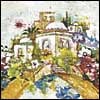Sha'ar Nikanor - Nikanor Gate
The Nikanor Gates led from the Ezrat Nashim to the Azarah. Fifteen semi-circular steps lead to this gate. On occasion, the Levites sang as they stood on these steps.
 The Fifteen Steps
The Fifteen Steps
At the western end of the Women's Courtyard were fifteen semi-circular steps. Each was half a cubit high and half a cubit deep. On occasion, the Levites sang as they stood on these steps.
Chamber of Instruments
 Near the base of the steps, built into the western wall of the Women's Courtyard, were two doors that led underneath the Azarah, which was built on higher ground than the Women's Courtyard.
Near the base of the steps, built into the western wall of the Women's Courtyard, were two doors that led underneath the Azarah, which was built on higher ground than the Women's Courtyard.
The doors led into a single large underground chamber called the Chamber of Instruments. Here the Levites conducted choir rehearsals and stored their instruments.
The Nikanor Gate
The doorway atop the fifteen semi-circular steps led into the Azarah. The first eleven cubits along the eastern side of the Azarah was called the Courtyard of the Israelites.
The gateway atop the fifteen steps that led into the Courtyard of the Israelites were called the Upper Gate, also known as the Nikanor Gate.
Nikanor was the benefactor who paid craftsmen in Alexandria, Egypt, to fashion the two large brass doors used for this gate.
Each door was 5 cubits by 20 cubits. The brass was carved with intricate designs, and its finish was exceedingly bright.
A Story:
As these doors were being sent by ship from Egypt to Judea, a storm broke out. The crew was forced to cast one of the two brass doors into the sea.
When the danger continued, the crew decided to toss the second gate out as well. Hearing their plans, Nikanor declared that if they throw out the door, they should throw him out as well. His self-sacrifice called for a miracle and the storm subsided. When the ship docked, the door cast overboard was miraculously found floating in the harbor.
All the Temple doors were plated with gold except the Nikanor gate. The rabbis wanted the people to see the "miracle doors" in their pristine form. Additionally, the brass finish had the appearance of fine gold.
The heavy doors required twenty men to open them. The Nikanor Gate was opened only on the Sabbath, festivals, and Rosh Chodesh. If the king was present in the Temple, the doors were also opened in his honor. On all other days, smaller gateways (to the left and right of Nikanor gate) were used.






The heavy doors required twenty men to open them. The Nikanor Gate was opened only on the Sabbath, festivals, and Rosh Chodesh. If the king was present in the Temple, the doors were also opened in his honor. On all other days, smaller gateways (to the left and right of Nikanor gate) were used.
PLEASE WILL YOU GIVE ME A SOURCE FOR THIS.
Thanks.
About when the Nikanor Gate was opened -
See Ezekiel, Chapter 46:1-3, and in Rashi there.
(See also Rambam's commentary to Mishna Shekalim 6:3, which mentions that the purpose of this type of smaller gateway is to be easily accessible at any time.)
About the heaviness of the doors -
This in general is a well-sourced idea, including as part of the miraculous story in which these gates received their name. However, I have not yet located the source which says it specifically required twenty people to open it.